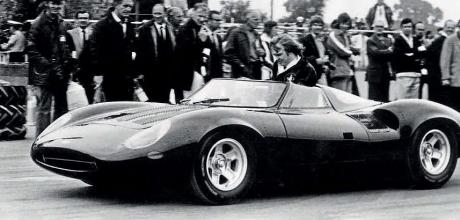Jaguar XJ13 makes its public debut, Silverstone, July 1973
By 1973 Jaguar’s motorsport glories were long behind it. It had been 16 years since one of its cars had last won the 24 Hours of Le Mans while even its final entry in the race it had once ruled was way back in 1964. And with parent company British Leyland lacking the resources to go racing, there seemed little chance of Jaguar returning to the track. Yet despite all of this, the company still had a presence at the 1973 British Grand Prix, albeit with a dated never-before-seen prototype.
When the mid-engined XJ13 had been developed in the mid-Sixties, it had been done in secret, tested behind prying eyes at the Motor Industry Research Association’s test track (MIRA) near Nuneaton. Despite racing driver David Hobbs once reaching 175mph, the project was canned in 1967 due to how long it had taken to be developed.
“By that time it was two years out of date”, said Jaguar’s then managing director, Lofty England, years later. “The modern trend of doubling the width of the tyres had come in, and to have got anywhere we would have had to do a lot of redesigning and rebuilding. Frankly, we didn’t have the time or the people to go into all that, so we put it to one side.”
The car should have made its public debut as part of a 1971 publicity film shot at MIRA for the new E-Type Series 3. But fitted with wheels and tyres that had been in storage since the car was cancelled, Jaguar’s test driver Norman Dewis lost control of the V12-engined car, crashing heavily. Despite rolling several times before coming to a stop on the circuit’s infield, Norman was largely unhurt. The XJ13, though, was badly damaged. It was returned to Browns Lane and placed in storage.
Yet surprisingly for a damaged prototype, the car wasn’t destroyed and a year later was spotted under a tarpaulin by Ted Loades from Abbey Panels, the Coventry coachbuilder which had originally been responsible for shaping the car’s aluminium body.
Loades made England (who had only recently replaced the now retired Sir William Lyons) an offer; Abbey would restore the XJ13 for £1000. “I saw my way of getting it rebuilt,” said Lofty to Autocar after the car had been completed. “Such a beautiful piece of machinery, I thought it was a pity to lose it.” Although 65 per cent of the panels needed to be replaced, some of the original wooden body formers were found still in storage at Jaguar’s Radford facility and four Abbey craftsmen set about recreating them from scratch. Yet it wouldn’t be exactly the same as before Norman’s crash since the wheelarches were slightly flared and the cooling was improved. Meanwhile, the mechanical parts, including the 5-litre V12, were overhauled by some of the same members of Jaguar’s experimental department who had built it.
When the XJ13 was finished in mid 1973 there was only one place suitably grand enough for the racer tomake its official public debut: the British Grand Prix at Silverstone on July 14.
With the car allowed to do some demonstration laps before the race itself, Lofty himself was behind the wheel with Lotus driver Gunnar Nilsson as a passenger. “It may not be this year’s model,” said Lofty during an interview around the time of the XJ13’s debut, “but isn’t it nice to see a really aerodynamic shape that also has the beauty of line associated with all Jaguars?”
He wasn’t the only one to think so. Although it was an unproven racing car that even by 1973 was old-fashioned, it still received a rapturous reception from the crowd. “The 5-litre V12 midengined Jaguar XJ13 was undoubtedly the Car of the Meeting,” was Motor Sport magazine’s assessment in its August 1973 issue. “What a pity it never raced at LeMans as was intended.” And 50 years later after this beautiful and iconic car finally made its debut, that view hasn’t changed.


